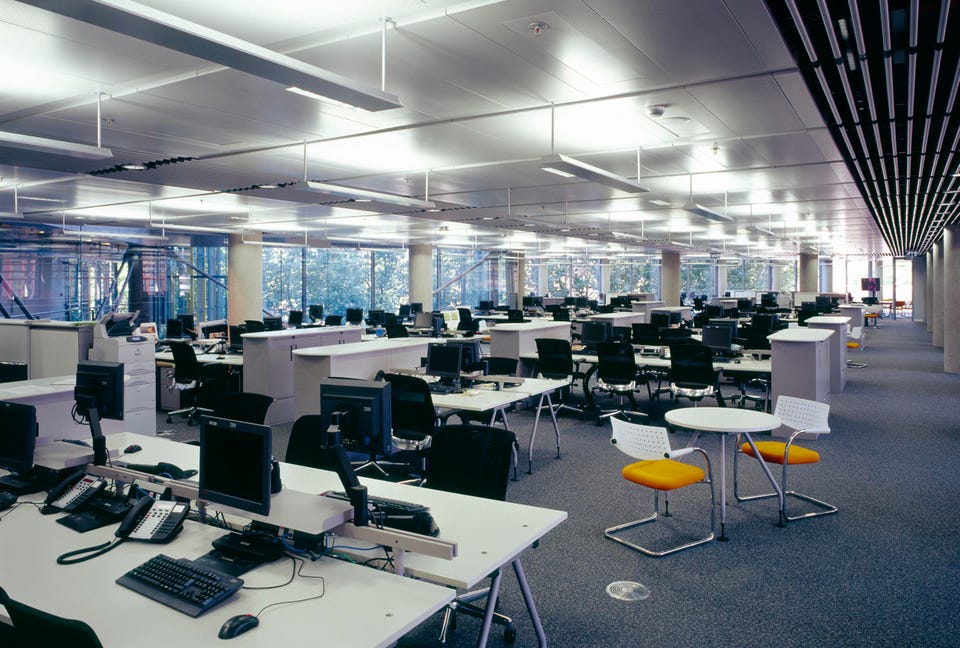Sustainability Can Energy Efficiency For Buildings And Indoor Air Quality Ever Be Reconciled? Jamie Hailstone Contributor Opinions expressed by Forbes Contributors are their own. I write about air quality and the environment. Following New! Follow this author to stay notified about their latest stories.
Got it! Oct 21, 2022, 03:52am EDT | New! Click on the conversation bubble to join the conversation Got it! Share to Facebook Share to Twitter Share to Linkedin Office in Waterside Building (Richard Rogers Partnership), Paddington Basin, London, UK. (Photo by . .
. [+] Andrew Holt/Construction Photography/Avalon/Getty Images) Getty Images When people talk about sustainability and all its many facets, outdoor air quality and the need to improve it are seen as a given. But whenever you mention indoor air quality, you get a slightly different reaction.
This maybe because for many years, it has become synonymous with heating and air conditioning systems, which can consume energy at an alarming rate and are therefore part of the problem, especially when it comes to decarbonization. However, if there is one thing, we have all learned from the pandemic, it’s that indoor air quality is not a luxury, it is a necessity, particularly if we are to all move to a healthier and more sustainable future. The question is how do reconcile the need for clean indoor air with the need to make buildings as energy efficient as possible? Christian Weeks, the CEO of enVerid Systems admitted there is often a tension between improving indoor air quality and making buildings as energy efficient as possible.
He said this is because the green building “playbook” dictates that buildings should be as air-tight, with as little ventilation as possible in order to make them energy efficient. The problem is that less ventilation negatively impacts indoor air quality, unless other measures are taken to control indoor generated contaminants. MORE FOR YOU They Inherited Billions Upon Billions: Meet America’s Richest Heirs Is Walmart Stock A Buy At $131? Christian McCaffrey Trade To The San Francisco 49ers: Analyzing The Fit And Finances While the indoor air quality “playbook” says throw open the windows and make sure there’s as much outdoor air ventilation in the building as possible, this means increased costs for both heating and air conditioning outside air used to dilute indoor generated contaminants.
This approach is especially energy intensive in hot and cold climates. It can also be counter productive when the outside air is not clean. “We believe there is a way to improve indoor air quality and climate resiliency while also saving energy and cost, and we call this Sustainable IAQ,” Weeks told Forbes.
The way to achieve Sustainable IAQ, according to Weeks, is to deploy proven air cleaning and filtration technologies to remove particles, pathogens, and gases like volatile organic compounds (VOCs) and ozone from indoor air, so that less outside air ventilation is needed to achieve good indoor air quality. The key is defining what is meant by good indoor air quality in terms of particles, pathogens and gases, and then deploying the right mix of air cleaning, filtration, and ventilation to achieve indoor air quality targets cost effectively and energy efficiently. “We need to control all three of them,” he added.
“And I would say the impact of the gases part is still not very well understood. For example, there’s a lot of talk about CO2 as an indicator of air quality, but CO2 is not a particularly good overall metric of indoor air quality as many contaminant sources do not depend on the number of people in a space generating CO2. ” Erik Malmstrom, the CEO of SafeTraces, said that the “cross disciplinary nature” of indoor air quality, touching everything from mechanical systems to infectious diseases, combined with the lack of clear, coherent regulations, standards, and building codes, creates a complex, confusing environment for building owners and operators.
“We don’t have a common definition of “good” indoor air quality that incorporates the most significant health and safety risk in buildings, airborne pathogens. That’s where the breakdown starts,” added Malmstrom. “Then, official guidelines frequently begin with a first and primary step of bringing in more outdoor air to improve indoor air quality, even while there are other more effective, as well as much more cost- and energy-efficient, ways to clean indoor air like filtration and disinfection, particularly with respect to pathogen protection.
” Weeks said filtration and cleaning is the “only way forward” for improving indoor air quality when the outside air is not “fresh” due to pollution. “To improve climate resiliency and reduce building emissions, we need to clean and recycle the air already in the building,” he said. “We already do this in other aspects of our lives.
We recycle wherever we can, because it’s resource efficient. We should do the same with our air. ” enVerid Systems, in collaboration with leading IAQ and energy efficiency companies 75F, Awair, GIGA, Oxygen8, Planled and SafeTraces, recently published a white paper, which lays out a roadmap to simultaneously improving indoor air quality and meeting building decarbonization and climate resiliency goals.
It recommends a ‘clean first’ framework that starts with defining indoor air quality goals, layering air cleaning, filtration, and ventilation technologies, continuous monitoring of indoor air quality, and the use of smart building controls to dynamically adjust air cleaning and ventilation for optimized indoor air quality, comfort and climate resiliency. “The twin challenges of the Covid-19 pandemic and climate change have underscored the need for healthy and green buildings, not just one or the other. Moreover, market, policy, and regulatory drivers are compelling real estate to act” added Malmstrom.
“While our traditional playbook puts indoor air quality and sustainability directly at odds, the clean first framework provides building owners and operators a valuable path to achieve both sets of goals, cost- and energy-efficiently. ” Follow me on Twitter or LinkedIn . Check out some of my other work here .
Jamie Hailstone Editorial Standards Print Reprints & Permissions.
From: forbes
URL: https://www.forbes.com/sites/jamiehailstone/2022/10/21/can-energy-efficiency-for-buildings-and-indoor-air-quality-ever-be-reconciled/



